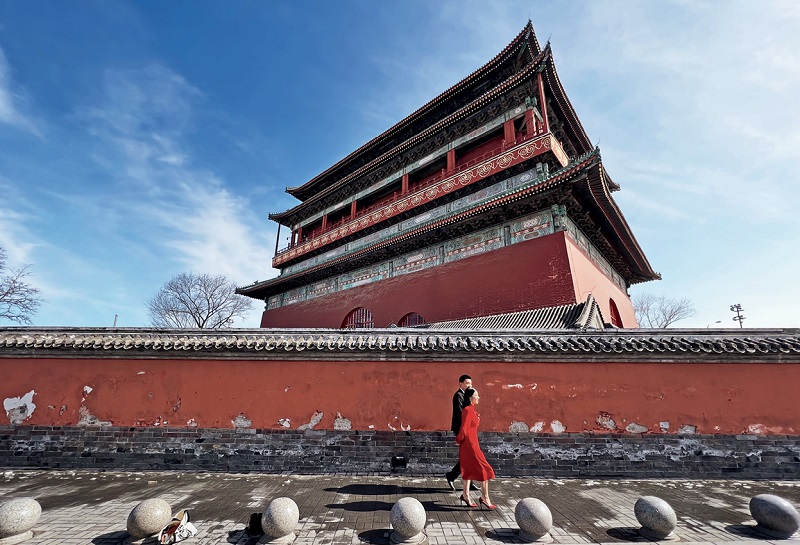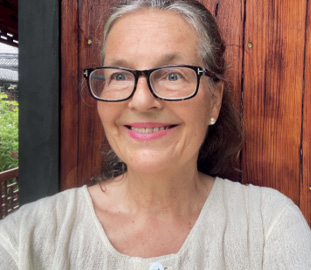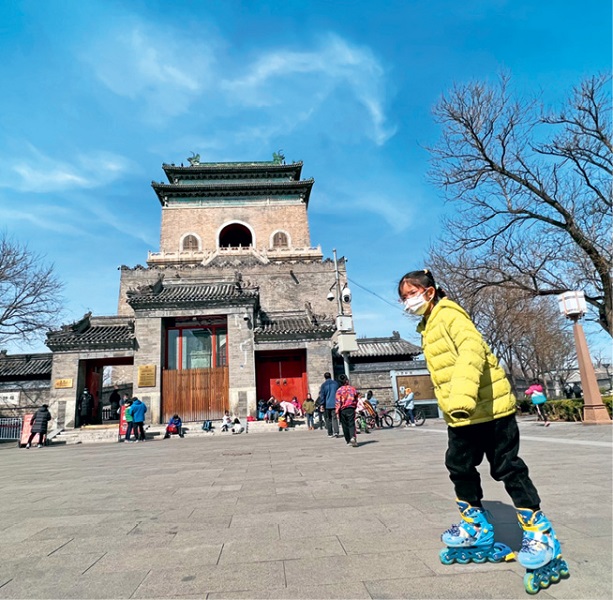A central axis represents the core of a city’s culture, signifying its features and identity.

The red wall surrounding the Drum Tower has become a popular destination for taking photos among young people.
Stretching from the Bell Tower and the Drum Tower in the north, to the Yongding Gate in the south, the 7.8 kilometer Beijing Central Axis has been the “cultural backbone” of the city for hundreds of years. Seen from the Drum Tower, the Central Axis is like a scroll of historical stories unfolding along its route, engendering a string of emotions in its many viewers.
Recording Daily Lives
In the vicinity of the Drum Tower, a grey-haired lady, camera in hand, is often seen recording stories happening around this historical building. She is Kosima Weber Liu from Germany, and has called China home for over four decades. Liu told China Today that she enjoyed cycling around exploring Beijing during her first visit to the city, and her first stop was the Drum Tower. She recalled that in the early days of her stay, a friend recommended that she visit the tower to watch a Peking Opera performance there. Subsequently, that night, sitting on a long, narrow wooden bench with her friend, she watched the iconic Chinese art form for the first time. She was captivated by the performers’ singing, reciting, acting, and martial arts skills.
To her surprise, the audience was not quiet, as she was culturally accustomed to, but had brought food and beverages and talked with each other while watching the show. Historical buildings, mesmerizing operas, and the caring interaction among people “made me fall in love with Chinese history and Beijing’s central axis,” she said.
Around the world, many cities have their own renowned central axis — the Champs Elysees in Paris, the Unter den Linden in Berlin, and the National Mall in Washington. A central axis represents the core of a city’s culture, signifying its features and identity. Liu said Beijing’s central axis has extraordinary cultural value, and is the combination of buildings and heritage sites that underpin the planning of the entire ancient capital. The Central Axis of Beijing is composed of 15 heritage sites including ancient imperial palaces, gardens and sacrificial complexes, administrative facilities, ritual and public buildings and old streets. They constitute an orderly arranged and sizable architectural complex in the country’s capital.
To explore more of Beijing, Liu has crossed the axis on many different occasions. On summer nights during her first couple of years in the city, she often cycled across the Tian’anmen Square to get together with friends and watch the sunset with them. On the famous square, children would run about flying kites while adults would stand by idly chatting. The nearby Dashilan Street and Wangfujing Commercial Street were always busy with traffic and pedestrians, bursting with vitality. Another major draw for the photographer was the old Yinding Bridge. In her mind, this is the most beautiful place in Beijing as it is like a home away from home, and she has long considered it a place where she finds inner peace in a foreign land.
During her leisure time, Liu often takes her camera and strolls through the hutongs (ancient alleyways) around Houhai, an old neighborhood in central Beijing. Each of the pictures she takes depicts a familiar story. Through her lens, she captures not only grand ancient buildings, but also lively scenes of people going about their day in the alleyways, children having fun at squares, and happy couples being photographed in front of the iconic red walls, all recording both the past and present, in a fusion of traditional culture and contemporary life.

A selfie of Kosima Weber Liu.
An Advancing Oriental Nation
In 1959, Liu’s father performed in China as a trombone player in the Staatskapelle Dresden of Germany, one of the oldest orchestras in the world, to celebrate the 10th anniversary of the founding of the People’s Republic of China. After his visit, he brought home many photos to show Liu, who was still a child back then, to help her get acquainted with this remote country.
In the summer of 1979, Liu signed up for a language course in Beijing. During this period, she travelled to many places in China and grew more interested in the country. After going back to Germany, she applied for a two-year exchange program of the German Academic Exchange Service. Back then, China had just begun to implement its reform and opening-up policy, and everything was not as convenient and accessible as it is today. “It was literally an adventure for me,” said Liu as she recalled her life in China at that time. She could only contact her family via letters. If she wanted to make a phone call, she had to go to the Beijing Hotel or a telephone office and the fee for a call would be exorbitant.
Although China was under-developed at the time, Liu was very optimistic about the country's development prospect. “I never thought about whether China was developed or not, or [that] my life [would] get difficult. China appealed to me in many ways. Here people were not obsessed with appearance or money. Everyone was leading a sustainable life. There were some difficulties living in China, but you could feel this country was making progress,” she said.
Having now lived in China for over 40 years, Liu has seen firsthand the process of reform and opening-up, along with the rapid change in life it has brought about. She lamented that people now take for granted the convenience and efficiency in their daily lives, something that was only a “fuzzy dream” 40 years ago. Towering skyscrapers, accessible and efficient facilities, and a proliferation of art activities provide a contemporary vibrant contrast to the old city, said Liu.

A girl is rolling blading around in front of the Bell Tower in Beijing.
Protection and Development of the Central Axis
In 1951, China’s renowned architect Liang Sicheng first proposed the notion of the Central Axis of Beijing, calling it “the world’s longest and greatest north-south central axis.” Since then, it has been in the spotlight on many occasions. At the opening ceremony of the 2008 Beijing Summer Olympics, the dazzling firework display “Giant Footprint" was set off from the Yongding Gate, extending along the Central Axis before arriving at the Bird Nest stadium. In 2011, Beijing’s Central Axis began its bid of having some of its sites listed as world cultural heritage sites. In 2022, the Chinese National Cultural Heritage Administration decided to recommend the Central Axis of Beijing for World Heritage status in 2024. And the required documents were submitted to the UNESCO World Heritage Centre in February 2023. The result will be announced at the 2024 World Heritage Convention.
Liu said that the bid and the protection measures are “encouraging.” She hoped that the Central Axis could set an example by helping other historical neighborhoods in Beijing receive adequate protection as well, in an era of modernization. Apart from majestic historical buildings, Beijing also boasts a complete hutong network, she added. In addition, there are old waterways, lakes and fountains, forming a developed water system. Liu believes this legacy should be preserved. “The more features are protected, the more lively Beijing will be. The protection of the Central Axis is an opportunity for us to consciously protect and pass on history, the living cultural heritage and traditional arts,” she said.
Beijing’s Central Axis has high architectural, historical and cultural value, and embodies the innovative development of the city. In terms of architectural aesthetics, constructions on the axis are arranged orderly. A chapter of Rites of Zhou, an ancient ritual classic of Confucianism, documents ancient Chinese’ early design ideas of a city — a square-shaped city with each side of 4.5 kilometers and three gates on each side, ancestral temple in the left, sacrificial temples on the right, imperial court in the front and market district in the back. The Central Axis of Beijing followed this rule, with the Forbidden City sitting at its heart, in conformity with the ancient Chinese tradition of considering the center as superior. On two sides of the Forbidden City, ancient rulers built the Imperial Ancestral Temple and the Alter of Land and Grain, based on ancient rites.
From the perspective of history and culture, the Central Axis of Beijing exhibits the inclusivity of the Chinese culture that has continued through changes of dynasties, witnessed the fusion of multiple ethnic cultures, and demonstrated the development of a multi-cultural civilization.
From the perspective of innovative development, the Central Axis has been changing with the times and seeking new elements. It is an age-old but young landscape — old because it dates back hundreds of years, and young considering it is still evolving. The imperial palaces, temples, towers, and gardens from the past have now become multi-functional public spaces to meet the needs of politics, the economy, culture, ecology, and society. Today, visitors can view a number of scenes along the Central Axis — the magnificent and solemn structures on and around the Tian’anmen Square show the grandeur of a major country; the bustling Dashilan commercial area suggests prosperity; the Forbidden City welcoming visitors from all parts of the world displays a rich cultural legacy; the Zhengyang Gate is a good place for bird-watching; and hutongs overflow with the daily lives of local residents.
This impressive Central Axis lies at the very heart of Beijing. In the future, China will continue to protect and develop this axis, keeping it alive and bursting with new vitality.